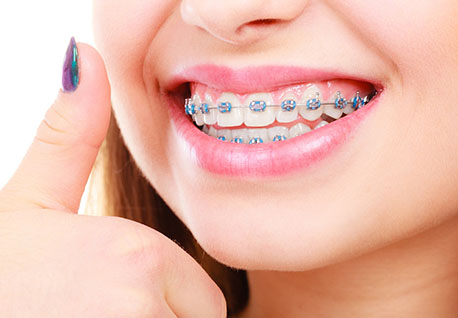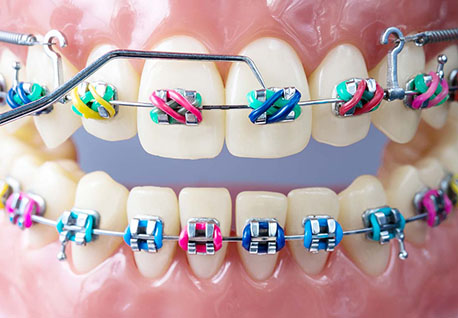Orthodontics
Dental braces and retainers are used by orthodontists to help to straighten crooked teeth and correct a misaligned bite in patients as young as 8 or 9. In some cases, a removable retainer will be all that’s necessary; in severe cases, surgery may be recommended. Braces, which consist of bands, wires, and other fixed or removable corrective appliances, work by applying continuous pressure over a period of time to slowly move teeth in a specific direction. Newer mini-braces, which are much smaller than traditional braces, are an option for some. Braces usually remain in place for 1-3 years, followed by the use of a retainer.

METHODS
For comprehensive orthodontic treatment, most commonly, metal wires (“Jushi”) are inserted into orthodontic brackets (see dental braces), which can be made from stainless steel or a more aesthetic ceramic material. The wires interact with the brackets to move teeth into the desired positions. Other methods may include Invisalign. Invisalign consists of clear plastic aligners that move teeth.
Additional components—including removable appliances (“plates”), headgear, expansion appliances, and many other devices—may also be used to move teeth and jaw bones. Functional appliances, for example, are used in growing patients (age 5 to 14) with the aim of modifying the jaw dimensions and relationship if these are altered. This therapy, termed Dentofacial Orthopedics, is frequently followed by fixed multibracket therapy (“full braces”) to align the teeth and refine the occlusion.
Orthodontics is the study of dentistry that is concerned with the treatment of improper bites, and crooked teeth. Orthodontic treatment can help fix the patient’s teeth and set them in the right place. Orthodontists usually use braces and retainers to set the patient’s teeth. There are, however, orthodontists who work on reconstructing the entire face rather than focusing exclusively on teeth. After a course of active orthodontic treatment, patients will typically wear retainers, which maintain the teeth in their improved positions while surrounding bone reforms around them. The retainers are generally worn full-time for a period, anywhere from just a few days to a year, then part-time (typically, nightly during sleep) for as long as the orthodontist recommends. It is possible for the teeth to stay aligned without regular retainer wear. However, there are many reasons teeth will crowd as a person ages, whether or not the individual ever experienced orthodontic treatment; thus there is no guarantee that teeth will stay aligned without retention. For this reason, many orthodontists prescribe night-time or part-time retainer wear for many years after orthodontic treatment (potentially for life). Adult orthodontic patients are more likely to need lifetime retention.

DIAGNOSIS AND TREATMENT PLANNING
In diagnosis and treatment planning, the orthodontist must
- Recognize the various characteristics of malocclusion or dentofacial deformity.
- Define the nature of the problem, including the etiology if possible.
- Design a treatment strategy based on the specific needs and desires of the individual.
- Present the treatment strategy to the patient in such a way that the patient fully understands the ramifications of his/her decision.
PATIENT'S TESTIMONIALS

Dr. Manish Raj who showed lots of concern and did a wonderful root canal therapy and saved my tooth."The meticulous and patient approach and that kind of human touch are worth mentioning. He acts with confidence and hence is always successful."
Dr. Varsha Agarwal
Consultant Pathologist KNMH,Prayagraj
Before coming to SMILE DESIGNER DENTAL HOSPITAL, I was always apprehensive to visit a dentist, and the result was that I had a bad caries molar tooth. There seemed no option except the loss of tooth. It was then Dr. Manish Raj who showed lots of concern and did a wonderful root canal therapy and saved my tooth." The meticulous and patient approach and that kind of human touch are worth mentioning. He acts with confidence and hence is always successful."
Chaya.P.Mishra
Consultant Nutritionist, Prayagraj
when I visited Dr.Manish Raj but he made everything appear extremely easy and comforted me. Thank you 'Smile designers'Everyone was so friendly and helpful. The office was very professional, and they really took the time to make me feel comfortable and welcome. Their commitment to making sure I was 100% satisfied.."
Nuzra Mansoor Khan
Lucknow
